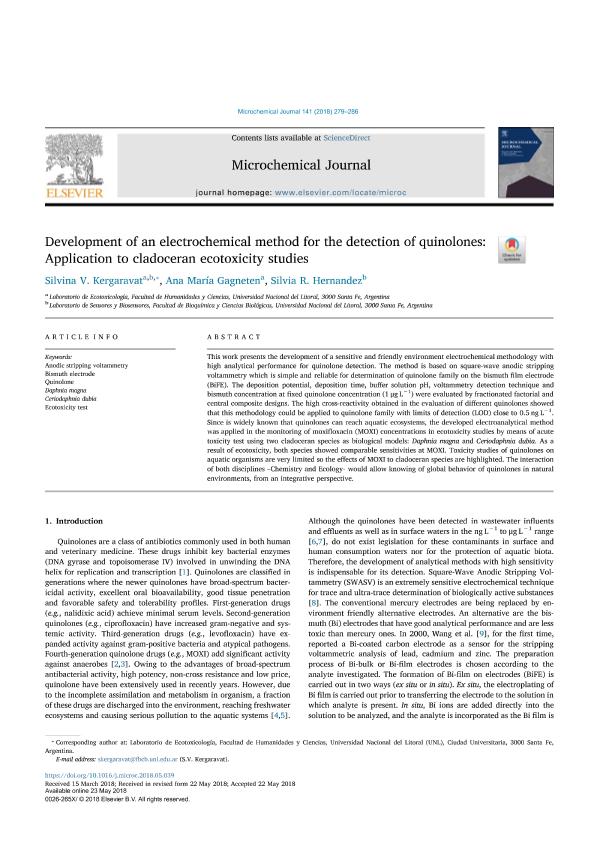Mostrar el registro sencillo del ítem
dc.contributor.author
Kergaravat, Silvina Vanesa

dc.contributor.author
Gagneten, Ana María

dc.contributor.author
Hernández, Silvia Raquel

dc.date.available
2019-11-21T17:13:48Z
dc.date.issued
2018-09
dc.identifier.citation
Kergaravat, Silvina Vanesa; Gagneten, Ana María; Hernández, Silvia Raquel; Development of an electrochemical method for the detection of quinolones: Application to cladoceran ecotoxicity studies; Elsevier Science; Microchemical Journal; 141; 9-2018; 279-286
dc.identifier.issn
0026-265X
dc.identifier.uri
http://hdl.handle.net/11336/89427
dc.description.abstract
This work presents the development of a sensitive and friendly environment electrochemical methodology with high analytical performance for quinolone detection. The method is based on square-wave anodic stripping voltammetry which is simple and reliable for determination of quinolone family on the bismuth film electrode (BiFE). The deposition potential, deposition time, buffer solution pH, voltammetry detection technique and bismuth concentration at fixed quinolone concentration (1 μg L−1) were evaluated by fractionated factorial and central composite designs. The high cross-reactivity obtained in the evaluation of different quinolones showed that this methodology could be applied to quinolone family with limits of detection (LOD) close to 0.5 ng L−1. Since is widely known that quinolones can reach aquatic ecosystems, the developed electroanalytical method was applied in the monitoring of moxifloxacin (MOXI) concentrations in ecotoxicity studies by means of acute toxicity test using two cladoceran species as biological models: Daphnia magna and Ceriodaphnia dubia. As a result of ecotoxicity, both species showed comparable sensitivities at MOXI. Toxicity studies of quinolones on aquatic organisms are very limited so the effects of MOXI to cladoceran species are highlighted. The interaction of both disciplines –Chemistry and Ecology- would allow knowing of global behavior of quinolones in natural environments, from an integrative perspective.
dc.format
application/pdf
dc.language.iso
eng
dc.publisher
Elsevier Science

dc.rights
info:eu-repo/semantics/openAccess
dc.rights.uri
https://creativecommons.org/licenses/by-nc-sa/2.5/ar/
dc.subject
Anodic strippin voltammetry
dc.subject
Bismuth electrode
dc.subject
Quinolone
dc.subject
Daphnia magna
dc.subject
Ceriodaphnia dubia
dc.subject
Ecotoxicity test
dc.subject.classification
Química Analítica

dc.subject.classification
Ciencias Químicas

dc.subject.classification
CIENCIAS NATURALES Y EXACTAS

dc.title
Development of an electrochemical method for the detection of quinolones: Application to cladoceran ecotoxicity studies
dc.type
info:eu-repo/semantics/article
dc.type
info:ar-repo/semantics/artículo
dc.type
info:eu-repo/semantics/publishedVersion
dc.date.updated
2019-10-28T16:48:51Z
dc.journal.volume
141
dc.journal.pagination
279-286
dc.journal.pais
Países Bajos

dc.journal.ciudad
Amsterdam
dc.description.fil
Fil: Kergaravat, Silvina Vanesa. Universidad Nacional del Litoral; Argentina
dc.description.fil
Fil: Gagneten, Ana María. Universidad Nacional del Litoral; Argentina
dc.description.fil
Fil: Hernández, Silvia Raquel. Universidad Nacional del Litoral; Argentina
dc.journal.title
Microchemical Journal

dc.relation.alternativeid
info:eu-repo/semantics/altIdentifier/url/http://linkinghub.elsevier.com/retrieve/pii/S0026265X18303461
dc.relation.alternativeid
info:eu-repo/semantics/altIdentifier/doi/http://dx.doi.org/10.1016/j.microc.2018.05.039
Archivos asociados
